Artist, painter, designer, genius, contrarian, provocateur: the self proclaimed one and only true Surrealist, Salvador Dalì, remains a pivotal figure not just within Surrealism, but the art world and popular culture as well.

Image source: https://in2english.net/2020/10/14/salvador-dali/
The life and the memory
The surrealist movement, founded in Paris by a small number of artists, writers, and intellectuals, was both a followup to the revolutionary cubist and dada currents, and a rejection of current trends of rationalism and realism as a predominant force, believieng them to be a barrier to man’s imagination; to unlock it once more, their focus was on the subconscious, the oniric plane, as the key.
Among them, one name in particular is remembered, despite his controversial position even within it, as the face of this movement: Salvador Dalì, himself credited with the rather bold claim that:
The difference between me, and other surrealists, is that I truly am Surrealist
Salvador Dalì
Salvador Dalì (full name Salvador Domingo Felipe Jacinto Dalí i Domènech, Ist Marquess of Dalí de Púbol) was born in Figueres, a Catalunian city, in 1904, son of a middle class notary. Displaying affinity for drawing since infancy, Dalì is sent to study art at the Real Academia de Bellas Artes de San Fernando, in Madrid (1921), where he matures his painting skills and bonds with poet Federico Garcìa Lorca and director Luis Buñuel; after his expulsion from the academy, he travels to Paris. During this period, two major influences helped shape his artistic style – the work of psychoanalist Sigmund Freud, namely the exploration of dreams and their innate eroticism, and the introduction to the Surrealist movement, through fellow artist Mirò, in 1929. His breakthrough in the art world comes the very same year, where he collaborates with Buñuel on his movie “Un chien Andalou” (“An Andalusian dog”), shocking spectators with is provocative and, for the time, scandalous imagery.
From this year onwards, Dalì begun his painting career, lasted until 1973; in his first works (The First Days of Spring, The Great Masturbator and The Lugubrious Game) he had started to explore his themes of unconscious desires and erotic anxiety, according tohis recently developed “Paranoiac-Critical method of accessing the subconscious”: this technique required the artist to fall into a unique state of mind, that he described as a “spontaneous method of irrational knowledge, based on the critical-interpretative association of the phenomena of delirium”; in more practical terms, the actively attempts to visualize images and incorporate them, often ambiguously, in the final product, diving deep within one’s subconscious; a frenetic, manic state, much different from the traditional “Psychic Automatism” of other surrealists.
[…] His work is the most hallucinatory that has been produced up to now
Andre Brèton, leader of the parisian Surrealists
In 1931, Dalì produced one of his most famous and discussed works, “The Persistence of Memory”, featuring the imagery of the soft, liquefying clock watches for the first time; with its dreamlike features, the imagery subverts and disrupts the common, rigid notions of reality, referencing not only his own experiences (the scene is set in Port Lligat, dear to the artist) but also the theories of Einstein, about the relativity of time, and Bergson, whom theorized that the essence of its passing was the sum of our experieces and emotions; the painting captured greatly the interest of visitors at the Gallery of New York, where it is exhibited.
During these same years, Dalì would meet Gala as well, his lifelong companion, wife, and muse, not to mention enormous influence over his career and style.
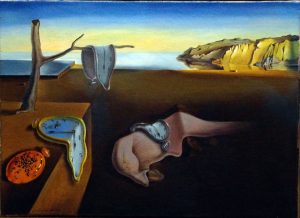
by hannibal1107
Image source: https://search.creativecommons.org/photos/ff6b8461-4909-4221-95d8-d821c4716428
Beyond Surrealism and Europe
The first rifts with the Surrealist community began during the 30s: in the wake of the Spanish Civil War (and subsequent fascist dictatorship), Dalì declared himself to be “apolitical”, whereas the majority of the movement were associated with left-wing positions, critiquing his refusal to denounce fascism; they would only grow further apart during the years, as fascist symbology began appearing in his imagery – despite Dalì’s claims of them only being the product of his visions, and not sympathies; this would only exacerbate until, 1939, with Dalì’s definitive breakup with the movement after his “process” and expulsion; his ideas, often extremist and contrarian (sometimes to the point of amorality) alienated him even from his close friends, Lorca and Buñuel; according to him, his peers were merely afraid of what he brought to his art and his lack of compromises, his inclusion of morbid imagery (insects, corpses, decomposition…), his refusal of abstractism.
The only difference between me and a madman is that I am not mad, the difference between me and surrealists is that I am surrealist for real.
Excerpt from Dali’s “Diary of a genius”
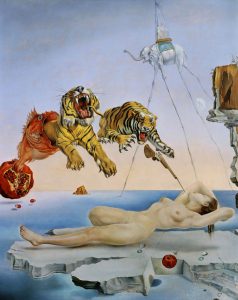
Following this, with the beginning of World War II, Dalì and Gala move to the United States, where the artist had already found success; in 1940, the couple is in New York, and for the Dalì is a phase of great experimentation, dedicating himself to photography, cinema, performance art. His belief that surrealism can’t be limited to “merely” poetry and painting translates into iconic designs, such as the lobster-phone or the Mae West Lips sofa, works that make him both rich (his nickname, “Avida Dollars”, was given to him by Breton, regarding his perceived greed) but very appreciated by the American market as well, setting the basis for future movements (such as Pop Art) and being recognized by local media as a protagonist of European art. In 1942, he publishes his autobiography, “The Secret Life of Salvador Dali”, and in 1946, works with director Alfred Hitchcock on “Spellbound”.

by Jim Linwood
Image source: https://search.creativecommons.org/photos/12fb8caf-35a4-476d-b1e3-5b1e7ed9fb86
The power of God, the power of man
This marks a period of great artistic maturity and change for Dalì as well: the atomic weapons, employed by the USA to bring an end to the conflict, leaving a deep impression on the artist, who’s both fascinated by atomic physics, and its implications on the nature of reality, and terrified by the ghost of a nuclear war; this interest becomes his “Atomic Mysticism”, where he explores, both conceptually and aestethically, fission, the atom, beauty, and reality.
_[…] many of the landscapes painted in this period express the great fear inspired in me by the announcement of that explosion [the Hiroshima “Fat Man” bomb]. I applied my paranoiac-critical method to exploring the world. I want to see and understand the forces and hidden laws of things, obviously so as to master them. To penetrate to the heart of things, I know by intuitive genius that I have an exceptional means: mysticism, that is to say, deeper intuition of what is, immediate communication with the all, absolute vision by grace of truth, by grace of God.
Dalì’s speech over his newfound mysticism

Image source: https://www.wikigallery.org/wiki/painting_243930/Salvador-Dali/Dematerialization-near-the-nose-of-Nero
At the same time, Dalì claimed to have grown closer to Catholic religion once more (or at the very least, to its symbolism), a stark departure from his “blasphemous” images from “L’age de l’or”. This new direction can be seen in paintings such as “The temptation of Saint Anthony”, where the titular man is threatened by four, spider legged elephants (symbolizing precarious fragility) carrying each a separate vice; this was part of Dalì’s then attempt at gaining a deeper understanding of reality itself.
To reach the heart of reality, I had the genial intuition of using an extraordinary weapon, mysticism, the deep intuition of “what it is”, the communion with the everythinh, the absolute vision through truth, through divine grace. More powerful than cyclotrons and calculators, I can penetrate the secrets of what is real in an instant…to me, estasy! The estasy of God and man.
Dalì’s newfound approach
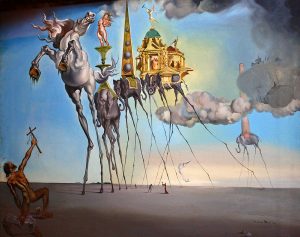
Author: Frans Vandewalle
Image source: https://www.flickr.com/photos/snarfel/3712541955
Return to Spain and last years
Dalí and Gala returned to Spain in 1948; at this point in his career, the artist was still prolific, while also enjoying considerable worldwide fame and prestige; numerous retrospectives, on both his art and life, are exhibited in Rome (1954), Tokyo (1964), Nagoya and Kyoto. Throughout the 60s, Dalì keeps working on a variery of projects, including paintings, sculptures, and writing books, the most famous of which being 1964’s “Diary of a Genius”. Dalì’s outrageous behaviour keeps intriguing the public, until 1980, when he falls victim to a stroke that prevents him from ever painting again; in ’82, Gala dies, leaving the artist in a deep depression; Dalì dies in 1989, in his castle in his hometown of Figueres, listening to Wagner.
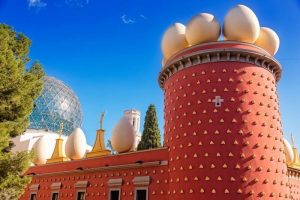
Image source: https://www.joysoftraveling.com/spain/tourists-guide-to-figueres-in-spain-the-birthplace-of-salvador-dali/
Dreaming the elephant’s dream

Author: cedric.vandamme
Image source: https://search.creativecommons.org/photos/4187c851-80eb-4c11-b332-8e5829ec83d7
Dalì, basing his imagery in a subconscious analysis of his dreams, has, through the years, given life to a vast catalogue of recurring themes and symbols observable in his body of work; often judged outrageous even by his contemporaries, the artist was not afraid to display dark, powerful themes, extracted (in his opinion) in the deepest recesses of his mind.
The liquefying clocks: one of Dalì’s trademarks, the melting clocks allude to the fluid lack of boundaries of reality, fusing itself with the human sensation and losing its objective meaning, taking its new place in the emotive sphere of perception.
The ants: a symbol of death and decline, the ephemeral state of man’s life; alternatively (due to deep bonds in subconscious analisys between death and eros) lust. This image appears to originate from Dalì’s infancy, seeing an insect being devoured whole by ants.
The egg: the duality, an hard exterior and soft interior, life before life; in Dalì’s symbology, it is a stand in for love and hope, birth and the universe.
The crutch: A support, something to hold on, offer stability to the weaker and unable to do so alone; a symbol of safety, even tradition.
The elephants: Tall and thin legged, the elephants of Dalì are in balance between strenghth and fragility, weight and weightlessness; despite their elephant nature, they move graciously and effortlessly, in a paradoxical, dream like atmosphere.
The drawers: “The human mind is filled with secret drawers, that only psychoanalysis can open”, recites Sigmund Freud. The same goes for Dalì, whose drawers symbolize hidden desires, sensuality – often female; their often semi-open nature suggets their unearthing, their extraction and exploration from the subconscious.
Dalì outside of Dalì
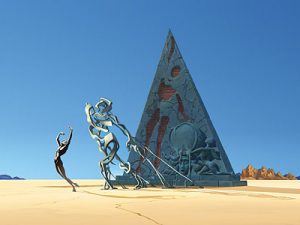
Image source: http://www.flicksnews.net/2011/12/check-this-destino.html
Due to his status as one of the 20th century most influential artists, not to mention his fame in both the Old and New Continent, Dalì was bound to appear and collaborate in a number of external projects, that stand today as a continuation of his legacy.
One of these is the short film “Destino”, a project started in 1945 and completed, many decades later, in 2003: a collaborative effort between Dalì’s unique art style and the already beloved animation expertise of the Walt Disney Studios. The project, telling the tale of Chronos, god of time, falling in love with the mortal woman Dahlia, remained unfinished (as it was deemed commercially unproductive) untile the next millennium, when, through the original storyboards and modern (including computer generated) brought it to life.
This wasn’t the first, nor the last, time cinema requested the help of Dalì; in the 70s, director Alejandro Jodorowski was tasked with adapting the literary epic of Dune, Frank Herbert’s magnum opus; Dalì was contracted to play the sinister ruler of the known galaxy, Emperor Padisha, accompanied by a flaming giraffe (although, due to Dalì demanding an extremely high compensation, he was planned to only appear briefly); however, as the project (whose production values became exorbitant) never came to be, only sketches remain, realized by French artist Jean Giruaud, better known as Moebius.

Image source: https://variety.com/2018/film/reviews/bunuel-in-the-labyrinth-of-the-turtles-review-1202990424/
Info sources:
https://www.wikiart.org/en/salvador-dali
https://en.wikipedia.org/wiki/Salvador_Dal%C3%AD
